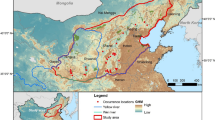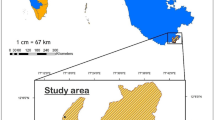Abstract
Suitable birth-site habitat is a crucial factor affecting the survival of offspring. The alpine musk deer (Moschus chrysogaster) is an endangered ungulate, native to the Qing-Tibetan Plateau and surrounding areas. In order to determine the birth-site habitat selection of alpine musk deer, we measured and compared 16 ecological variables recorded through transect survey in Xinglongshan National Nature Reserve from July to August, 2021. The results showed that alpine musk deer preferred habitat with higher elevation (2619.67 m ± 22.28 m), steeper slope (35.06°±1.72°), higher arbor canopy (37.67%±6.50%), shrub canopy (55.00%±2.02%), ground-plant cover (83.19%±3.71%), and number of fallen trees (0.18 ± 0.08 /plot). The ecological variables affecting birth-site habitat selection were ranked according to contribution values as follows: shrub canopy, ground-plant cover, number of fallen trees and slope, which was supported by 79.9% correct discrimination rate. Furthermore, alpine musk deer preferred habitat with good concealment (60.61%), minor human activity interference (63.64%) and closer distance to the nearest water source (87.88%). The birth-site habitat selection of alpine musk deer is a comprehensive trade-off of their ecological needs, including security, food availability and water resource. Therefore, reducing the human activities interference and protecting forest edges in altitude of birth-site habitat are conductive to improve the habitat suitability of alpine musk deer.

Similar content being viewed by others
Data Availability
The information of all data used in the study is available in School of Environment and Natural Resources, Renmin University of China.
References
Barbknecht AE, Fairbanks WS, Rogerson JD, Maichak EJ, Scurlock BM, Meadows LL (2011) Elk parturition site selection at local and landscape scales. J Wildl Manage 75:646–654. https://doi.org/10.1002/jwmg.100
Blank DA, Yang W (2017) Mother-young recognition in goitered gazelle during hiding period. Behav Process 142: 21–28. https://doi.org/10.1016/j.beproc.2017.05.016
Bleich VC, Marshal JP, Andrew NG (2010) Habitat use by a desert ungulate: Predicting effects of water availability on mountain sheep. J Arid Environ 74:638–645. https://doi.org/10.1016/j.jaridenv.2009.10.019
Briefer E, Mcelligott AG (2011) Mutual mother–offspring vocal recognition in an ungulate hider species (Capra hircus). Anim Cogn 14:585–598. https://doi.org/10.1007/s10071-011-0396-3
Brook RK (2010) Habitat selection by parturient elk (Cervus elaphus) in agricultural and forested landscapes. Can J Zool 88:968–976. https://doi.org/10.1139/Z10-061
Bowyer RT, Van BV, Kie JG, Maier JAK (1999) Birth-site selection by Alaskan moose: maternal strategies for coping with a risky environment. J Mammal 80:1070–1083. https://doi.org/10.2307/1383161
Cheng SG, Zou ZH (1991) Feed and nutrition of musk deer. Sichuan Science and Technology Press, Chengdu. [in Chinese]
Cheng ZB, Bai JD (2015) Study on the behavior of birthing-rearing in semi-dispersed elk. Beijing Academy of Science and Technology, Beijing. [in Chinese]
Cody ML (1978) Habitat selection and interspecific territoriality among the sylviid warblers of England and Sweden. Ecol Monogr 48:351–396. https://doi.org/10.2307/2937239
Desbiez ALJ, Kluyber D, Massocato GF, Oliveira-Santos LGR, Attias N (2020) Life stage, sex, and behavior shape habitat selection and influence conservation strategies for a threatened fossorial mammal. Hystrix 31:123–129. https://doi.org/10.4404/hystrix-00375
Estes RD, Estes RK (2010) The birth and survival of wildebeest calves. J Comp Ethol 50:45–95. https://doi.org/10.1111/j.1439-0310.1979.tb01015.x
Gaillard JM, Festa-Bianchet M, Yoccoz NG, Loison A, Toigo C (2000) Temporal variation in fitness components and population dynamics of large herbivores. Annu Rev Ecol Syst 31:367–393. https://doi.org/10.1146/annurev.ecolsys.31.1.367
Green MJB (1986) The distribution, status and conservation of the Himalayan musk deer Moschus chrysogaster. Biol Conserv 35:347–375. https://doi.org/10.1016/0006-3207(86)90094-7
Green W, Aron R (1993) Asynchronous parturition in bison: implications for the hider-follower dichotomy. J Mammal 74:920–925. https://doi.org/10.2307/1382430
Jian YD (2017) A habitat selection of giant panda in Laoxiancheng National Nature Reserve. Dissertation, Northwestern University. [in Chinese]
Kaze J, Whiting JC, Freeman ED, Bates SB, Larsen RT (2017) Birth-site selection and timing of births in American bison: effects of habitat and proximity to anthropogenic features. Wildl Res 43:418–428. https://doi.org/10.1071/WR15205
Khadka KK, James DA (2016) Habitat selection by endangered Himalayan musk deer (Moschus chrysogaster) and impacts of livestock grazing in Nepal Himalaya: implications for conservation. J Nat Conserv 31:38–42. https://doi.org/10.1016/j.jnc.2016.03.002
Li J, Li YK, Liu WH (2017) Autumn bed site selection by sika deer (Cervus nippon) in the Taohongling National Nature Reserve, China. Russ J Ecol 48:384–391. https://doi.org/10.1134/S1067413617040105
Michel ES, Gullikson BS, Brackel KL, Schaffer BA, Jenks JA, Jensen WF (2020) Habitat selection of white-tailed deer fawns and their dams in the Northern Great Plains. Mammal Res 65:825–833. https://doi.org/10.1007/s13364-020-00519-6
Moser B, Schütz M, Hindenlang KE (2008) Resource selection by roe deer: Are windthrow gaps attractive feeding places? For Ecol Manag 255:1179–1185. https://doi.org/10.1016/j.foreco.2007.10.023
Nelson JJ, Gillam EH (2017) Selection of foraging habitat by female little brown bats (Myotis lucifugus). J Mammal 98:222–231. https://doi.org/10.1093/jmammal/gyw181
Pan SX, Meng XX, Feng JC, Zhou YJ, Xu HF (2007) A review of studies on habitat selection by small and solitary forest ruminants. J Zhejiang For Coll 24:357–362 [in Chinese]
Phillips GE, Alldredge AW (2000) Reproductive success of elk following disturbance by humans during calving season. J Wildl Manage 64:521–530. https://doi.org/10.2307/3803250
Rachlow JL, Terry BR (1991) Interannual variation in timing and synchrony of parturition in Dall’s sheep. J Mammal 72:487–492. https://doi.org/10.2307/1382131
Rearden SN, Anthony RG, Johnson BK (2011) Birth-site selection and predation risk of Rocky Mountain elk. J Mammal 92:1118–1126. https://doi.org/10.1644/09-MAMM-A-019A.1
Sheng HL, Liu ZX (2007) Muscidae of China. Shanghai Science and Technology Press, Shanghai. [in Chinese]
Singh NJ, Grachev IA, Bekenov AB, Milner-Gulland EJ (2010) Saiga antelope calving site selection is increasingly driven by human disturbance. Biol Conserv 143:1770–1779. https://doi.org/10.1016/j.biocon.2010.04.026
Singh PB, Saud P, Cram D, Mainali K, Thapa A, Chhetri NB, Poudyal LP, Baral HS, Jiang ZG (2019) Ecological correlates of Himalayan musk deer Moschus leucogaster. Ecol Evol 9:4–18. https://doi.org/10.1002/ece3.4435
Speten D (2014) Assessment of mule deer fawn survival and birth site habitat attributes in south-central Oregon. Oregon State University, Corvallis. https://ir.library.oregonstate.edu/concern/graduate_thesis_or_dissertations/xw42nb984
Subedi A, Aryal A, Koirala RK, Timilsina YP, Meng XX, Mckenzie F (2012) Habitat ecology of Himalayan musk deer (Moschus chrysogaster) in Manaslu Conservation Area, Nepal. Int J Zool Res 8:81–89. https://doi.org/10.3923/ijzr.2012.81.89
Thapamagar T, Magar KT, Pandey M, Bhandari S, Bhusal DR (2018) Habitat preferences and conservation status of Himalayan musk deer (Moschus chrysogaster) in Langtang National Park. J Ecol & Nat Resour 2(6):000152. https://doi.org/10.23880/jenr-16000152
Torres RT, Carvalho JC, Panzacchi M, Linnell JDC, Fonseca C (2011) Comparative use of forest habitats by roe deer and moose in a human-modified landscape in southeastern Norway during winter. Ecol Res 26:781–789. https://doi.org/10.1007/s11284-011-0837-0
Wang J, Ji SN, Wu JY, Shrestha TK, Bu XL, Zhu YJ, Xiang RW, Sheng Y, Meng XX (2021) Away from the city: habitat selection of badgers in mountainous area around Beijing. Biologia 76:1737–1746. https://doi.org/10.2478/s11756-020-00673-x
Wang J, Wang P, Aryal A, Meng XX, Weladji RB (2018) Summer habitat selection of reindeer (Rangifer tarandus) governs on the unprotected forest and human interface in China. Ekol (Bratisl) 37:112–121. https://doi.org/10.2478/eko-2018-0011
Wiseman PA, Carling MD, Byers JA (2006) Frequency and correlates of birth-site fidelity in pronghorns (Antilocapra americana). J Mammal 87:312–317. https://doi.org/10.1644/05-MAMM-A-180R1.1
Wu JY, Wang J, Zhu YJ, Bu Xl, Xiang RW, Lu QB, Cui SP, Hao YH, Sheng Y, Meng XX (2020) Summer habitat selection and impacts of human disturbance on leopard cats (Prionailurus bengalensis). Ecosyst Health Sust 6:1–11. https://doi.org/10.1080/20964129.2020.1856630
Yuan BD, Pan Y, Yan YF (2018) Den habitat selection of the chinese bamboo rat (Rhizomys sinensis) in Northern Guangxi China. Indian J Anim Res 52:431–437. https://doi.org/10.18805/ijar.v0iOF.8460
Yuan NY, Qin YH, Wang J, Shen LQ, Gao HX, Xiang RW, Zhu YJ, Li Y, Zhou M, Bai SL, Sheng Y, Meng XX (2021) Musk secretion of endangered Alpine musk deer (Moschus chrysogaster): muscone content and the relationships to age, health, mating history and enclosure condition. Biologia 76:3761–3767. https://doi.org/10.1007/s11756-021-00879-7
Zhao C (2018) Nutrition diet strategy, micro-habitat selection and evaluation of Alpine musk deer (Moschus sifanicus) in Helan Mountains, China. Northeast Forestry University, Haerbin. [in Chinese]
Acknowledgements
The authors are especially grateful to Mr. Bhakta B. Shrestha who helped to improve the language.
Funding
This research was supported by the National Natural Science Foundation of China (32170489, 31672300).
Author information
Authors and Affiliations
Corresponding author
Ethics declarations
Ethical approval
This study was carried out in accordance with the local ethical committee, received approval from the institutional review board of Renmin University of China, and complied with the current Chinese law.
Competing Interests
The authors declare that they have no conflicts of interest to this work.
Additional information
Publisher’s Note
Springer Nature remains neutral with regard to jurisdictional claims in published maps and institutional affiliations.
Rights and permissions
Springer Nature or its licensor (e.g. a society or other partner) holds exclusive rights to this article under a publishing agreement with the author(s) or other rightsholder(s); author self-archiving of the accepted manuscript version of this article is solely governed by the terms of such publishing agreement and applicable law.
About this article
Cite this article
Shen, L., Gao, H., Wu, J. et al. Birth-site habitat selection of wild alpine musk deer (Moschus chrysogaster) in the northeastern qing-tibetan plateau of China. Biologia 78, 141–147 (2023). https://doi.org/10.1007/s11756-022-01246-w
Received:
Accepted:
Published:
Issue Date:
DOI: https://doi.org/10.1007/s11756-022-01246-w




